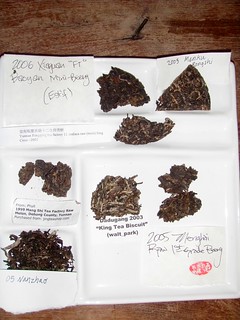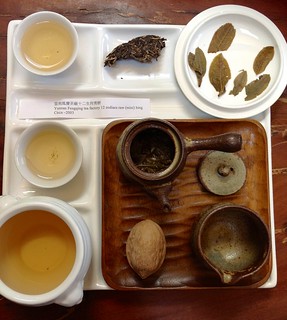In 2006, bearsbearsbears brilliantly organized a Live Journal pu-erh taste-off which was a great way of sharing within the community. I still have these treasured samples which I have stored in an airtight tin for 6 years so it may answer some questions I have aging under sealed conditions.
Just from color of the leaves alone, it looks like these guys changed some because none of them have that greenish young sheng tinge. Without squinting, the 2006 Xiaguan FT and the 2005 Nanzhao definitely looks darker than the 1999 Mangshi Melon. So how do they taste? I may take decades to find out.
I still have sizeable chunks left because you will see from my setup below that I only need a pinky tip's worth and the samples were generous. My sheng tasting teapot is about the size of a walnut so it allows me to make numerous infusions without having to drink a litre.
I chose the 2003 Feng Qing Zodiac for this morning since I drink the 2001 Feng Qing Ripe regularly and I had planned to do a little creative shu-sheng blending after the show... Feng Qing Factory in Lincang is one of the original factories(1939) which has the recipe last digit #4 after Xiaguan #3. They changed their name to Dian Hong group but I have only seen low-end pu-erh from them recently. The 2003 Zodiac appears to have been a special issue and it was not on sale over the internet even back then.
This mini is now a 10 year old and the brew color is still roughly similar to what it was in 2006 as compared with Jason's review. I normally take a few sips for flavor and dump the rest into the larger bowl which you can see looks darker but the color in the cup is still the hay hues of a youngster. It must have matured if only a little because the smokiness and grassy green notes which were definitely present in it's infancy were gone. The bitterness was slight, not harsh at all. Only after the 6th brewing, I tasted some slight camphor notes.
It's kind of pleasant albeit boring tea but it still ripped up my stomach. You can see from the spent leaves that it's pretty much plantation leaves. I cherry picked the whole leaves but there's no shortage of broken leaves and stems in the teapot.
Aging is occurring albeit very slowly and due to my limited experience with dry-aged sheng tens and tweens, I'm not sure really what to expect. I went through Hobbe's posts for 2002/2003 tastings and his brews definitely look darker. So back to my previous post about aging in sealed conditions, these samples were in ziplock bags in a airtight puzzle tin for 6 years. Some aging has occurred. But for my collection, I have to find out if they aged any more quickly than my cakes which were sitting on a shelf. Also I have to account for differences in sample size vs. whole beengs as the rate of aging for broken samples should be somewhat accelerated. The real problem is that I can't tolerate sheng so I can't do serious taste testings to efficiently determine this fact. The only solution is to send away samples to experienced drinkers. Just from color of the leaves alone, it looks like these guys changed some because none of them have that greenish young sheng tinge. Without squinting, the 2006 Xiaguan FT and the 2005 Nanzhao definitely looks darker than the 1999 Mangshi Melon. So how do they taste? I may take decades to find out.
I still have sizeable chunks left because you will see from my setup below that I only need a pinky tip's worth and the samples were generous. My sheng tasting teapot is about the size of a walnut so it allows me to make numerous infusions without having to drink a litre.
I chose the 2003 Feng Qing Zodiac for this morning since I drink the 2001 Feng Qing Ripe regularly and I had planned to do a little creative shu-sheng blending after the show... Feng Qing Factory in Lincang is one of the original factories(1939) which has the recipe last digit #4 after Xiaguan #3. They changed their name to Dian Hong group but I have only seen low-end pu-erh from them recently. The 2003 Zodiac appears to have been a special issue and it was not on sale over the internet even back then.
This mini is now a 10 year old and the brew color is still roughly similar to what it was in 2006 as compared with Jason's review. I normally take a few sips for flavor and dump the rest into the larger bowl which you can see looks darker but the color in the cup is still the hay hues of a youngster. It must have matured if only a little because the smokiness and grassy green notes which were definitely present in it's infancy were gone. The bitterness was slight, not harsh at all. Only after the 6th brewing, I tasted some slight camphor notes.
It's kind of pleasant albeit boring tea but it still ripped up my stomach. You can see from the spent leaves that it's pretty much plantation leaves. I cherry picked the whole leaves but there's no shortage of broken leaves and stems in the teapot.


Hello hster,
ReplyDeletepray tell, why do you think that the leaves come from plantations? They seem quite strong to me on the photo...
Thanks!
Jakub
HI Jakub,
ReplyDeleteI thought the leaves looked too perfect and uniform. Also when something is gushu or wild tree, it is always advertised on the wrapper. I looked up the wrapper http://puerh-tea.livejournal.com/51443.html?thread=548083
just now and I dont see any the usual characters-
Wild arbor (野放), Wild tree (gŭshù, 古树), 野生 乔木 ( wild tall tree).
Hster
I still have two tongs of this tea, which I have not even touched since the tasteoff. I should really bring it out for a retaste.
ReplyDelete